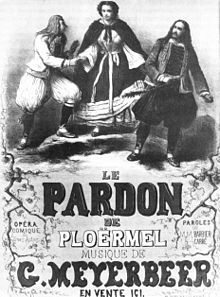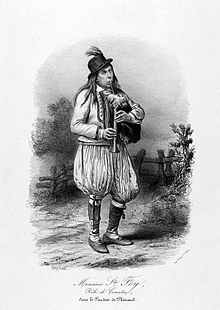- Dinorah
-
Giacomo Meyerbeer  Operas
Operas- Jephtas Gelübde (1812)
- Margherita d'Anjou (1820)
- L'esule di Granata (1822)
- Il crociato in Egitto (1824)
- Robert le diable (1831)
- Les Huguenots (1836)
- Ein Feldlager in Schlesien (1844)
- Le prophète (1849)
- L'étoile du nord (1854)
- Dinorah (1859)
- L'Africaine (1865)
Dinorah, originally Le pardon de Ploërmel (The Pardon of Ploërmel),[1] is an 1859 French opéra comique in three acts with music by Giacomo Meyerbeer and a libretto by Jules Barbier and Michel Carré.[2] The story takes place near the rural town of Ploërmel and is based on two Breton tales by Émile Souvestre, "La Chasse aux trésors" and "Le Kacouss de l'Armor", both published separately in 1850 in the Révue de deux mondes.[3]
Contents
Performance history
The opera was first performed at the Opéra-Comique (Salle Favart), in Paris, on April 4, 1859 under the title Le pardon de Ploërmel. The stage designs for Acts 1 and 3 were by Edouard-Désiré-Joseph Despléchin and Chéret.[4] Those for the more technically demanding Act 2, which included onstage running water, were by Joseph and Karl Wilhelm Mühldorfer. The principal singers were highly acclaimed: "Marie Cabel for her vertiginous-virtuoso interpretation of Dinorah; Sainte-Foy for his overwhelmingly convincing characterization of Corentin, lyrically as well as dramatically; Jean-Baptiste Faure for his fascinating stage presence as Hoël, Meyerbeer's first big baritone role."[5] The supporting singers were also greatly admired, in particular, Barreille as the huntsman and Warot as the harvester. Meyerbeer's music was praised for its originality, but the libretto was found incomprehensible and even met with derision. In the initial run of performances up to the end of 1859, changes were made, the most significant being the casting of the contralto Palmyre Wertheimber in the role of Hoël.[5]
The opera was translated into Italian for its premiere in London on July 26, 1859 (with Miolan-Carvalho), became internationally known as Dinorah, and was first seen in New York in 1862. (It is also sometimes known as Les chercheurs de trésor.) Under its original title it received over 200 performances at the Opéra-Comique by 1912.[6]
The opera was initially extremely popular and became a great favorite of Adelina Patti, but is nowadays virtually forgotten except for the famous virtuoso aria for soprano "Ombre légère", sometimes known as the Shadow Song as it is a one-sided 'duet' by Dinorah with her shadow. Other sopranos who have enjoyed considerable success in the role of Dinorah are Amelita Galli-Curci, Ilma di Murskal, Luisa Tetrazzini and Maria Barrientos.
Although the opera has been largely neglected in recent years,[7] a rare broadcast performance of the overture by Arturo Toscanini and the NBC Symphony Orchestra from November 12, 1938, has been preserved.[8] This unusual overture has several sections with chorus, ample percussion, and is seen to compare favorably with those of Rossini and Verdi.
Roles
Role Voice type Premiere cast,[6] April 4, 1859
(Conductor: Meyerbeer)Dinorah, a peasant girl soprano Marie Cabel Shepherd soprano Breuillé Shepherd mezzo-soprano Emma Belia Corentin, a bag-piper tenor Charles-Louis Sainte-Foy Goatherd soprano Dupuy Goatherd soprano Marguerite Decroix Hoël, a goat-herd baritone Jean-Baptiste Faure A huntsman bass Barreille[9] A harvester tenor Victor Warot Loïc baritone Lemaire Claude tenor Palianti Chorus: peasants and villagers Synopsis
- Time:
- Place:
Act 1
In the Breton village of Ploërmel
During the annual pilgrimage to the chapel of the Virgin, Dinorah has gone mad because her bridegroom Hoël disappeared following a storm that interrupted their wedding on the same day the previous year. Hoël returns to the village, having discovered the whereabouts of a treasure. He enlists Corentin to help him recover the riches, but not without sinister intent, since according to the legend, the first to touch them will perish.
Act 2
A mysterious valley
They descend upon the cache where Dinorah also happens to be. From her, Corentin learns about the legend, and later he and Hoël invite each other first to inspect the treasure. During that time, Dinorah, in pursuit of her pet goat, steps on a tree trunk by a river as it is hit by lightning, and falls in the water and is swept away by the current. Hoël having witnessed the scene leaps to her rescue.
Act 3
Hoël admits his love and regrets to Dinorah as she regains consciousness. She recognizes him and regains her sanity. The villagers arrive and sing a hymn of forgiveness and lead the two lovers to the chapel where they will be married.
Recordings
- Dinorah - Deborah Cook (Dinorah), Christian du Plessis (Hoël), Alexander Oliver (Corentin) - Geoffrey Mitchell Choir, Philarmonia Orchestra - James Judd (conductor) - Opera Rara (1979)
- The aria "Ombre légère" has been recorded by many coloratura sopranos, including Maria Callas, Joan Sutherland, Anna Moffo, and Natalie Dessay.
Libretto and scores
Meyerbeer's manuscripts have not been found, and most published libretti reflect cuts to the score made in almost all productions. A complete libretto has recently been published by Cambridge Scholars Publishing as part of the series Giacomo Meyerbeer: The Complete Libretti in Eleven Volumes.[10] The following are the early printed sources which were used in the preparation of that libretto:
- Le Pardon de Ploërmel; opéra-comique en trois actes. Paris: Brandus & Dufour, 1859. (First edition of the full orchestral score with spoken dialogue.)
- Le Pardon de Ploërmel; opéra en trois actes. “Edition contenant les récitatifs et les morceaux ajoutés par l’auteur.” Paris: Benoit, 1885. (Score with sung recitatives in place of spoken dialog.)
- Le Pardon de Ploërmel; opéra-comique en trois actes. Paris: Michel Lévy Frères, 1859. (Second edition of the libretto used for additional stage directions and scenic descriptions.)
References
- Notes
- ^ In France the opera is most often performed as Le pardon de Ploërmel. Some revivals in France and most performances outside of France have used the name Dinorah. Other titles have included Le Pardon de Notre-Dame d'Auray and Les Chercheurs d'or. (Wild and Charlton, p. 353)
- ^ Additions to the libretto were made in German by Meyerbeer and Charlotte Birch-Pfeiffer and translated into French by Georges-Frédéric Burguis and Joseph Duesburg respectively (Arsenty, p. 1).
- ^ Wild and Charlton, p. 353; Letellier, p. 187. (Letellier gives the title of the second story as "Le Kacouss de l'amour".)
- ^ Letellier, p. 196, gives the full name of the set designer Chéret as Jules Chérets (sic); Henze-Döhring, p. 682, gives his name as Jean Louis Chéret (1810–1882).
- ^ a b Letellier, p. 196.
- ^ a b Wolff 1953, p. 135.
- ^ Kobbé comments: "...Meyerbeer evidently wanted to write a pastoral opera... now, instead of pastoral it sounds pasteurised."
- ^ Wilson, John (2002). "Toscanini Discography". ToscaniniOnline.com. http://www.toscaninionline.com/disco17.htm. Retrieved November 7, 2010.
- ^ The real name of the bass singer using the stage name of Barreille was Alexandre-Maximilien Bonvoux (Letellier, p. 241).
- ^ Arsenty, pp. 2–3.
- Sources
- Arsenty, Richard, editor (2008). The Meyerbeer Libretti: Opéra Comique 2 Le Pardon de Ploërmel (with an introduction by Robert Letellier). Newcastle upon Tyne: Cambridge Scholars. ISBN 978-1-84718-969-1.
- Henze-Döhring, Sabine, editor (2004). Giacomo Meyerbeer: Briefwechsel und Tagebücher, 1856–1859 (German), volume 7. Berlin: Walter de Gruyter. ISBN 978-3-11-018030-5.
- Huebner, Steven (2008). "Dinorah" at Grove Music Online.
- Kobbé, Gustav; Harewood, Earl of (1958). Kobbé's Complete Opera Book. New York: Putnam. OCLC 560129867, 10720244 and 637971238.
- Letellier, Robert Ignatius (2008). An Introduction to the Dramatic Works of Giacomo Meyerbeer: Operas, Ballets, Cantatas, Plays, p. 195. Hampshire, England: Ashgate. ISBN 978-0-7546-6039-2.
- Wild, Nicole; Charlton, David (2005). Théâtre de l'Opéra-Comique: Repertoire 1762–1972 (French). Sprimont, Belgium: Mardaga. ISBN 978-2-87009-898-1.
- Wolff, Stéphane (1953). Un demi-siècle d'Opéra-Comique (1900–1950). Paris: André Bonne. OCLC 250469567, 459125672 and 2174128.
- Online sources
External links
- Le pardon de Ploërmel: Free scores at the International Music Score Library Project. (Includes vocal scores in French and Italian.)
Categories:- French-language operas
- Operas by Giacomo Meyerbeer
- Operas
- 1859 operas
- Opéras comiques
- Opéra-Comique world premieres
Wikimedia Foundation. 2010.



